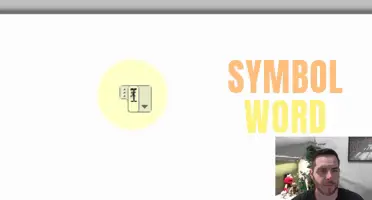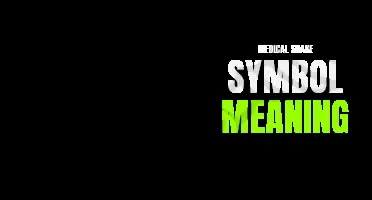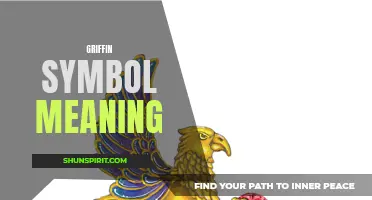
Cobra, a slithering and venomous creature, has fascinated humans for centuries with its mystical symbolism. This enigmatic serpent holds both fear and admiration in its coils, representing power, transformation, and life force. In various cultures and mythologies, the cobra takes on different meanings, from representing death and danger to signifying protection and rebirth. So, delve into the intriguing world of cobra symbolism, as we unravel the hidden messages behind this mesmerizing creature.
What You'll Learn
- What does the cobra symbolize in different cultures and religions?
- What is the significance of the cobra as a symbol in ancient Egyptian mythology?
- How is the cobra portrayed in Hinduism and what does it represent?
- In traditional Chinese culture, what does the cobra symbolize and what are its connotations?
- How has the cobra been used as a symbol in contemporary popular culture and what meanings does it convey?

What does the cobra symbolize in different cultures and religions?
The cobra, a venomous snake known for its distinctive hood and upright stance, has long been a symbol in various cultures and religions around the world. This fascinating creature holds different meanings and interpretations, often representing both positive and negative aspects depending on the cultural context. Let's explore how the cobra is symbolized in different cultures and religions.
In ancient Egyptian culture, the cobra was highly revered and associated with the goddess Wadjet, often depicted as a cobra or a woman with a cobra's head. The cobra symbolized protection and royalty, and its image was used to ward off evil spirits and bring good fortune. The cobra's ability to strike with deadly precision made it a symbol of power and authority, often associated with the pharaohs and their ability to protect Egypt.
In Hinduism, the cobra is associated with Lord Shiva, one of the principal gods in the Hindu pantheon. Lord Shiva is often depicted with a cobra around his neck, symbolizing his mastery over death and the destructive forces in the universe. The cobra also represents Kundalini, the dormant spiritual energy believed to reside within every individual. When awakened, this energy is said to rise through the body, symbolized by a coiled cobra, leading to spiritual enlightenment.
In Chinese mythology, the cobra is associated with the goddess Nüwa, who is believed to have created mankind. The cobra is seen as a symbol of protection and fertility, and its image is often carved or painted on Chinese artifacts. The Chinese also have a legend about a mythical snake called the "White Snake," who takes the form of a woman and falls in love with a mortal. This story symbolizes forbidden love and the struggle between good and evil.
In Native American cultures, the cobra is associated with healing and transformation. The shedding of its skin symbolizes a process of renewal and rebirth. The cobra is often depicted in Native American artwork and is seen as a guardian spirit, protecting against evil and bringing good fortune. The Native Americans also believe that the cobra possesses powerful medicine that can be accessed for healing and spiritual purposes.
In Buddhism, the cobra symbolizes protection and vigilance. It is often depicted as an ornament on the hoods of statues of the Buddha, representing the Buddha's ability to dispel fear and ignorance. The cobra's raised hood is seen as a symbol of awakening and enlightenment, with its sharp fangs representing the cutting through of delusions.
In conclusion, the cobra holds various meanings in different cultures and religions. It represents protection, power, fertility, transformation, healing, and enlightenment, among other things. Whether seen as a sacred creature or a symbol of danger, the cobra has captivated the human imagination throughout history and continues to be a powerful symbol in various cultural and religious contexts.
Unraveling the Hidden Meanings of the Half Circle Symbol
You may want to see also

What is the significance of the cobra as a symbol in ancient Egyptian mythology?
The cobra holds great significance in ancient Egyptian mythology and is often associated with various deities and symbols. In Egyptian mythology, the cobra is known as the symbol of Lower Egypt and is closely linked to the pharaohs and their power.
One of the most well-known representations of the cobra in ancient Egypt is the Uraeus, a stylized upright cobra placed on the front of the pharaoh's headdress. The Uraeus was believed to provide the pharaoh with protection and divine authority. It was a symbol of the pharaoh's sovereignty and represented their ability to control and defeat enemies.
The cobra was also associated with the goddess Wadjet, who was the protector of Lower Egypt. Wadjet was often depicted as a cobra or a woman with the head of a cobra. She was believed to be a fierce and protective deity who guarded the pharaoh and defended the kingdom against its enemies. Wadjet was an important goddess in Egyptian mythology and had her temple in Buto, which was the cult center of her worship.
In addition to its association with Wadjet, the cobra was also linked to other deities such as the sun god Ra, the goddesses Isis and Nekhbet, and the god Horus. The cobra was seen as a symbol of divine protection and was often depicted alongside these deities in Egyptian art and temples.
Furthermore, the cobra was believed to have magical and protective properties. It was often used in amulets, jewelry, and other protective charms. Egyptians believed that wearing these cobra amulets would bring them good luck, ward off evil spirits, and protect them from harm.
The cobra's association with power, protection, and divinity made it an integral part of ancient Egyptian mythology and culture. It symbolized the pharaoh's authority, the gods' protection, and the spirituality of the Egyptian people. The cobra, through its representations and symbolism, played a significant role in the religious and spiritual beliefs of the ancient Egyptians.
Decoding the Volvo Dashboard Symbols: What Do They Really Mean?
You may want to see also

How is the cobra portrayed in Hinduism and what does it represent?
In Hinduism, the cobra holds significant symbolism and is often portrayed in various ways. The representation of the cobra can be found in mythology, religious rituals, and even in the depiction of Hindu deities. The cobra is typically associated with Lord Shiva, one of the principal deities in Hinduism, and is depicted as wrapping around his neck like a sacred ornament. There are several interpretations of the cobra's significance in Hinduism, and it is believed to represent various aspects.
One of the most commonly attributed meanings to the cobra in Hinduism is its association with power and energy. The cobra is often seen as a symbol of kundalini, a spiritual energy believed to be coiled at the base of the spine in every individual. When awakened, this energy is said to rise through the seven chakras, or energy centers, ultimately leading to spiritual enlightenment. The cobra's coiled position around Lord Shiva's neck represents the awakened kundalini energy, symbolizing the immense power and potential that lies within every individual.
Additionally, the cobra is also seen as a symbol of protection and fertility. Cobras are known for their ability to defend themselves and their young fiercely. In Hindu mythology, the cobra's association with Lord Shiva is believed to provide protection to those who seek his blessings. Devotees often pray to Lord Shiva with the belief that he will shield them from harm and grant them strength and courage. Furthermore, the cobra is also linked to fertility, as it sheds its skin and renews itself, symbolizing the cycle of life, death, and rebirth.
In some depictions of Lord Vishnu, another prominent deity in Hinduism, he is shown resting on the coils of a massive serpent called Shesha. Shesha is often depicted as a multi-headed cobra with its hoods spread out, forming a protective umbrella over Lord Vishnu. This representation emphasizes the cobra's role as a guardian and protector.
The cobra is also associated with various Hindu goddesses, such as Maa Manasa and Maa Nagamma. Maa Manasa is a serpent goddess worshipped mainly in Bengal and Eastern India. She is believed to have the power to cure snake bites and is often depicted with a cobra around her neck. Maa Nagamma is worshipped in the southern parts of India, particularly in Tamil Nadu. She is considered the goddess of snakes and is believed to protect devotees from snake bites and other dangers.
In summary, the cobra holds great symbolism in Hinduism. It represents power, energy, protection, fertility, and the eternal cycle of life. The cobra's association with Lord Shiva, Lord Vishnu, and various goddesses underscores its significance in Hindu mythology and religious practices. It serves as a reminder of the inherent strength and potential within individuals and the divine protection and guidance offered by the deities.
The Complete Guide to Cadillac Escalade Dashboard Symbols and Meanings
You may want to see also

In traditional Chinese culture, what does the cobra symbolize and what are its connotations?
The cobra is a snake that holds great significance in traditional Chinese culture. In Chinese mythology, the cobra is often seen as a powerful and mythical creature, with various connotations and symbolisms.
In Chinese culture, the cobra is associated with protection and good fortune. It is believed to possess a potent and protective energy that can ward off evil spirits and negative influences. Because of this, the cobra is often depicted as a guardian or protector in Chinese art and folklore. It is believed that having a depiction of a cobra in one's home or carrying a cobra amulet can bring luck and protect against harm.
Another connotation of the cobra in Chinese culture is its association with strength and resilience. The cobra is known for its venomous bite and its ability to defend itself when threatened. This characteristic of the cobra is seen as a symbol of strength and resilience in the face of adversity. In Chinese martial arts and folklore, the cobra is often used as a symbol of power and determination.
Furthermore, the cobra is also associated with wisdom and knowledge in Chinese culture. The cobra's ability to shed its skin and renew itself is seen as a metaphor for personal growth and transformation. In Chinese philosophy, the cobra is often used as a symbol for wisdom and enlightenment, representing the journey of self-discovery and spiritual development.
In traditional Chinese medicine, the cobra is believed to possess medicinal properties and is used in various remedies. The venom of the cobra is thought to have healing properties and is sometimes used in small amounts for its therapeutic effects. However, it is important to note that the use of cobra venom in medicine should only be done by trained professionals and under proper guidance.
Overall, the cobra holds great significance in traditional Chinese culture and its connotations often revolve around protection, strength, wisdom, and resilience. Whether it be as a guardian, symbol of power, or an emblem of personal growth, the cobra symbolizes various aspects of life and is deeply rooted in Chinese mythology and folklore.
Unlocking Mysteries: Archangel Symbols and Their Profound Meanings
You may want to see also

How has the cobra been used as a symbol in contemporary popular culture and what meanings does it convey?
The cobra is a fascinating creature that has been used as a symbol in contemporary popular culture in various ways. Whether it's in movies, literature, or even fashion, the cobra has been portrayed as both an object of fear and as a symbol of power and protection.
One of the most famous uses of the cobra as a symbol in popular culture is in the movie "Raiders of the Lost Ark." In this film, the cobra is shown as a deadly creature that guards the Ark of the Covenant. Its presence serves as a deterrent for anyone attempting to steal the powerful artifact. The cobra in this context represents fear and danger.
In literature, the cobra has been used as a symbol to convey various meanings. In Rudyard Kipling's "Rikki-Tikki-Tavi," a children's story about a mongoose who protects a family from a pair of cobras, the cobra represents evil and danger. Its venomous nature and the threat it poses to the protagonist and his family illustrate the dangers presented by the cobra.
In fashion, the image of a cobra can be seen on various accessories, such as belts, wallets, and jewelry. These items often convey a sense of power and protection. The cobra is seen as a formidable creature that can strike fear into the hearts of others. By wearing or owning items with a cobra motif, individuals may feel a sense of empowerment and strength.
The cobra has also been used as a symbol in music. In the song "Cobra" by Black Veil Brides, the lyrics depict the struggle between good and evil. The cobra is used as a metaphor for evil and the protagonist's fight against it. The song conveys a message of strength and resilience in the face of adversity.
Overall, the cobra has been used as a symbol in contemporary popular culture to convey various meanings. From representing fear and danger to symbolizing power and protection, the cobra is a versatile symbol that can evoke different emotions and ideas. Whether it's in movies, literature, fashion, or music, the cobra continues to capture our imagination and inspire both fear and admiration.
Frequently asked questions
In many cultures, the cobra symbolizes power, protection, and transformation. In ancient Egyptian culture, the cobra, specifically the cobra goddess Wadjet, was associated with royalty and protection. In Hinduism, the cobra is a symbol of the god Shiva and represents rebirth and destruction. In Buddhism, the cobra is a symbol of wisdom and is often shown protecting the Buddha.
In dream symbolism, a cobra can represent both danger and transformation. Seeing a cobra in a dream may be a sign of hidden threats or the presence of someone who is deceptive or manipulative. Alternatively, a cobra in a dream can symbolize personal transformation, shedding old habits or beliefs, and embracing a new phase of life.
The symbolism of the cobra can be seen as both positive and negative, depending on the context. On one hand, the cobra is often associated with power, protection, and transformation, which are generally positive attributes. However, the cobra can also represent danger, deceit, and violence. Ultimately, the interpretation of the cobra's symbolism depends on the specific cultural or religious context in which it is being used.







